#obsession so strong is transcends timelines
Explore tagged Tumblr posts
Text



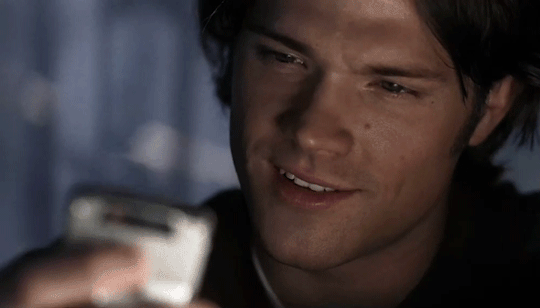
sam "thirsty for his brother in every timeline" winchester
#bbygrl you got it BAD#like you barely even KNOW him and you STILL wanna jump his bones#obsession so strong is transcends timelines#(also i'm not dead i just wasn't in the headspace to watch ahbl for like a month oops)#emma rewatches spn#2x20 what is and what should never be#spn#wincest#samdean
276 notes
·
View notes
Text
I found this from Naver while searching about the story so lemme edit the mtl a bit for people who want to know more about it~

Husband Thief
Author: Alphatart
Clacey, now married to her beloved Kishin and expecting their first child, is finally living her happy ending-or so it seems, until she finds herself hanging off a cliff, desperately holding the hand of her beloved niece, and Grand Duchess, Meron! The youngest daughter of the Count's family, Clacey, and her niece Meron are only five years apart, but after the death of her older sister, Clacey took on the role of raising her niece Meron. Meron is a lovely young lady on the outside, but she is obsessed with Clacey and interferes with her love life. Clacey needs to marry to secure her inheritance, and that's when the perfect man, Kishin, comes into her life. Boldly, Clacey asks him out, and Kishin, intrigued by her genuine nature despite her noble status, takes an interest. Kishin's friend, Dernick, also shows interest in the bold Clacey, but in fact, Dernick is the future Grand Duke, and Meron, knowing this, decides to marry Dernick. Clacey and Kishin get married and live a happy family life. Meron also forces through her marriage with Dernick, but Dernick only drifts through an affectionless marriage. Meron, who thought Dernick would be the perfect husband, instead wants to take Kishin for herself and seize Clacey's happiness into her own hqnds. Then, by chance, Meron gains magic that turns back time. Mistaking this as Meron's attempt to commit suicide, Clacey throws herself off the cliff with Meron, and they open their eyes three years in the past. Clacey asks Kishin on a date, and the two get married. The same past should repeat, but it keeps going awry. Clacey finds out about Meron’s plan to steal Kishin. She makes a fateful decision to protect Kishin, whom she loves, from the husband thief. Will Clacey be able to protect her husband?

#Love and Obsession That Transcends Time and Space
The narrative of Clacey returning to the past to get her beloved husband back presents a strong drama. While the same timeline repeats, the events constantly change due to Meron’s schemes, increasing the reader’s immersion. Clacey, who risks everything to protect her loved one, and Meron’s crazy and obsessive schemes guarantee an interesting development in every episode.

#The Tangled Fate of Four People
The entangled relationships between Clacey and Kishin, and Dernick and Meron are the unmissable charm points of the above work. Clacey and Kishin, who fall in love like fate. Meron, who doesn't love Kishin but wants to be loved by him. Dernick, who doesn't love Meron but can't refuse her because she's the daughter of his benefactor, and Meron, who loves Dernick. Their fates become entangled as they return to the past, and the ending flows unpredictably

#A Familiar Story in an Unfamiliar World
The story set in the European upper class provides a unique atmosphere that cannot be found in modern dramas. The historical background, such as arranged marriages and inheritance of property, gives new plausibility to the characters. However, the relationship between Clacey and Meron at the center is not unfamiliar. As rivals and aunts and nieces, their love-hate relationship drives the story and draws empathy from readers. You can enjoy a unique work through the combination of an unfamiliar worldview and a familiar story.
*tho honestly it’s more the author’s own (fantasy) worldview than historically accurate 😅
0 notes
Text
A review of “Journey Into Mystery,” the penultimate Loki Season One episode on Disney+, coming up just as soon as I paper cut a giant cloud to death…
Journey Into Mystery was the title of the first Marvel comic to feature either Thor or Loki. It began as an anthology series featuring monsters and aliens, but Jack Kirby, Stan Lee, and Larry Lieber were so smitten with their adaptation of the characters of Norse myth that the Asgardians gradually took over the whole book, which was renamed after its hammer-wielding hero(*).
(*) The early Journey Into Mystery stories treated Thor’s alter ego, disabled Dr. Donald Blake, as the “real” character, while Thor was just someone Blake could magically transform into, while retaining his memories and personality. It wasn’t even clear whether Asgard itself was meant to exist at first, until Loki turned up on Earth in an early issue, caused trouble, and Blake/Thor somehow knew exactly how to get to Asgard to drop him off. Soon, the lines between Thor and Blake began to blur, and eventually Thor became the real guy, and Blake a fiction invented by Odin to humble his arrogant son. It’s a mark of just how instantly charismatic Loki was that the entire title quickly steered towards him and the other gods.
But once upon a time, anything was possible in Journey Into Mystery, which makes it an apt moniker for an absolutely wonderful episode of Loki where the same holds true. Our title characters are trapped in the Void, a place at the end of time where the TVA’s victims are banished to be devoured by a cloud monster named Alioth. And mostly they are surrounded by the wreckage of many dead timelines. Classic Loki insists that his group’s only goal is survival, and any kind of planning and scheming is doomed to kill the Loki who tries. But this ruined, hopeless world instead feels bursting with imagination and possibility.
There are the many Loki variants we see, with President Loki, among others, joining Classic, Kid, Boastful, and Alligator Loki. There are the metric ton of Easter Eggs just waiting to be screencapped by Marvel obsessives (I discuss a few of them down below), but which still suggest a much larger and weirder MCU even if you don’t immediately scream out “Is that… THROG?!?!?” at the appropriate moment. And all of that stuff is tons of fun, to be sure. But what makes this episode — and, increasingly, this series — feel so special is the way that it explores the untapped potential of Loki himself, in his many, many variations.
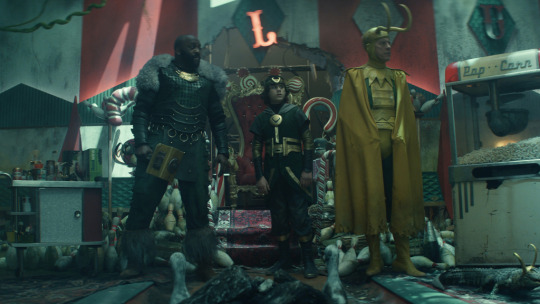
This is an episode that owes more than a small stylistic and thematic debt to Lost. It’s not just that Alioth looks and sounds so much like the Smoke Monster(*), that it makes a shared Wizard of Oz reference to “the man behind the curtain” (also the title of one of the very best Lost episodes), or even that the core group of Lokis are hiding in a bunker accessible via a hatch and a ladder that’s filled with recreational equipment (in this case, bowling alley lanes). It’s also that Loki, Sylvie, their counterparts, and Mobius have all been transported to a strange place that has disturbing echoes from their own lives, that operates according to strange new rules they have to learn while fleeing danger, and their presence there allows them to reflect on the many mistakes of their past and consider whether they want to, or can, transcend them.
(*) Yes, Alioth technically predates Smokey by a decade (see the notes below for more), but his look has been tweaked a bit here to seem more like smoke than a cloud, and the sounds he makes when he roars sound a lot like Smokey’s telltale taxi cab meter clicks. Given the other Lost hat tips in the episode, I have to believe Alioth was chosen specifically to evoke Smokey.
Classic Loki is aptly named. He wears the Sixties Jack Kirby costume, and he is a far more powerful magician than either Sylvie or our Loki have allowed themselves to be. He calls our Loki’s knives worthless compared to his sorcery, which feels like the show acknowledging that the movies depowered Loki a fair amount to make him seem cooler. But if Classic Loki can conjure up illusions bigger and more potent than his younger peers, he is a fundamentally weak and defeated man, convinced, like the others, that the only way to win the game into which he was born is not to play. “We cannot change,” he insists. “We���re broken. Every version of ourselves. Forever.” It is not only his sentiment — Kid Loki adds that any Loki who tries to improve inevitably winds up in the Void for their troubles — but it seems to have weighed on him longer and harder than most.
But Classic Loki takes inspiration from Loki and Sylvie to stand and fight rather than turn and run, magicking up a vision of their homeland to distract Alioth at a crucial moment in Sylvie’s plan, and getting eaten for his trouble. He was wrong: Lokis can change. (Though Kid Loki might once again argue that Classic Loki’s death is more evidence that the universe has no interest in any of them doing so.) And both Loki and Sylvie have been changing throughout their time together. Like most Lokis, they seem cursed to a life of loneliness. Sylvie learned as a child that a higher power believed she should not exist, and has spent a lifetime hiding out in places where any friends she might make will soon die in an apocalypse. Our Loki’s past isn’t quite so stark, but the knowledge that his birth father abandoned him, while his adoptive father never much liked him, have left permanent scars that govern a lot of his behavior. The defining element of Classic Loki’s backstory is that he spent a long time alone on a planet, and only got busted by the TVA when he attempted to reconnect with his brother and anyone else he once knew. This is a hard existence, for all of them. And while it does not forgive them their many sins(*), it helps contextualize them, and give them the knowledge to try to be better versions of themselves.
(*) Loki at one point even acknowledges that, for him, it’s probably only been a few days since he led an alien invasion of New York that left many dead, though due to TVA shenanigans, far more time may have passed.
For that matter, Mobius is not the stainless hero he once thought of himself as. While he and Sylvie are tooling around the Void in a pizza delivery car (because of course they are), he admits that he committed a lot of sins by believing that the ends justified the means, and was wrong. He doesn’t know who he is before the TVA stole and factory rebooted him, but he knows that he wants something better for himself and the universe, and takes the stolen TemPad to open up a portal to his own workplace in hopes of tearing down the TVA once and for all. Before he goes, though, he and Loki share a hug that feels a lot more poignant than it should, given that these characters have only spent parts of four episodes of TV together. It’s a testament to Hiddleston, Wilson, Waldron, and company (Tom Kauffman wrote this week’s script) that their friendship felt so alive and important in such a short amount of time.
The same can be said for Loki and Sylvie’s relationship, however we’re choosing to define it. Though they briefly cuddle together under a blanket that Loki conjures, they move no closer to romance than they were already. If anything, Mobius��� accusations of narcissism in last week’s episode seem to have made both of them pull back a bit from where they seemed to be heading back on Lamentis. But the connection between them is real, whatever exactly it is. And their ability to take down Alioth — to tap into the magic that Classic Loki always had, and to fulfill Loki’s belief that “I think we’re stronger than we realize” — by working together is inspiring and joyful. Without all this nuanced and engaging character work, Loki would still be an entertaining ride, but it’s the marriage of wild ideas with the human element that’s made it so great.
Of course, now comes the hard part. Endings have rarely been an MCU strength, give or take something like the climax of Endgame, and the finales of the two previous Disney+ shows were easily their weakest episodes. The strange, glorious, beautiful machine that Waldron and Herron have built doesn’t seem like it’s heading for another generic hero/villain slugfest, but then, neither did WandaVision before we got exactly that. This one feels different so far, though. The command of the story, the characters, and the tone are incredibly strong right now. There is a mystery to be solved about who is in the big castle beyond the Void (another Loki makes the most narrative and thematic sense to me, but we’ll see), and a lot to be resolved about what happens to the TVA and our heroes. And maybe there’s some heavy lifting that has to be done in service to the upcoming Dr. Strange or Ant-Man films.
It’s complicated, but on a show that has handled complexity well. Though even if the finale winds up keeping things simpler, that might work. As Loki notes while discussing his initial plan to take down Alioth, “Just because it’s not complicated doesn’t mean it’s bad.” Though as Kid Loki retorts, “It also doesn’t mean it’s good.”
Please be good, Loki finale. Everything up to this point deserves that.
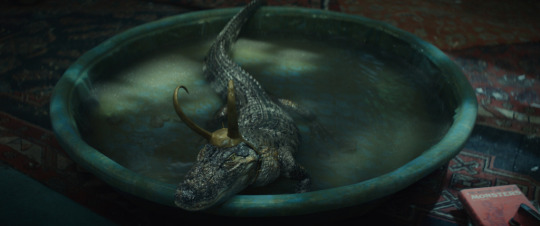
Some other thoughts:
* Most of this week’s most interesting material happens in the Void. But the scenes back at the TVA clarify a few things. First, Ravonna is not the mastermind of all this, and she was very much suckered in by the Time-Keeper robots. But unlike Mobius or Hunter B-15, she’s so conditioned to the mission that even knowing it’s a lie hasn’t really swayed her from her mission. She has Miss Minutes (who herself is much craftier this week) looking into files about the creation of the TVA, but for the most part comes across as someone very happy with a status quo where she gets to be special and pass judgment on the rest of the multiverse.
* Alioth first appeared in 1993’s Avengers: The Terminatrix Objective, a miniseries (written by Mobius inspiration Mark Gruenwald, and with some extremely kewl Nineties art full of shoulder pads, studded collars, and the like) involving Ravonna, Kang, and the off-brand versions of Captain America, Iron Man, and Thor (aka U.S. Agent, War Machine, and Thunderstrike, the latter of whom has yet to appear in the MCU). It’s a sequel to a Nineties crossover event called Citizen Kang. And no, I still don’t buy that Kang will be the one pulling the strings here, if only because it’s really bad storytelling for the big bad of the season to have never appeared or even been mentioned prior to the finale.
* Rather than try to identify every Easter egg visible in the Void’s terrain, I’ll instead highlight three of the most interesting. Right before the Lokis arrive at the hatch, we see a helicopter with Thanos’ name on it. This is a hat tip to an infamous — and often memed — out-of-continuity story where Thanos flies this chopper while trying to steal the Cosmic Cube (aka the Tesseract) from Hellcat. (A little kid gets his hands on it instead and, of course, uses the Cube to conjure up free ice cream.) James Gunn has been agitating for years for the Thanos Copter to be in the MCU. He finally got his wish.
* The other funny one: When the camera pans down the tunnel into Kid Loki’s headquarters, we see Mjolnir buried in the ground, and right below it is a jar containing a very annoyed frog in a Thor costume. This is either Thor himself — whom Loki cursed into amphibianhood in a memorable Walt Simonson storyline — or another character named Simon Walterston (note the backwards tribute to Walt) who later assumed the tiny mantle.
* Also, in one scene you can spot Yellowjacket’s helmet littering the landscape. This might support the theory that the TVA, the Void, etc., all exist in the Quantum Realm, since that’s where the MCU version of Yellowjacket probably went when his suit shorted out and he was crushed to subatomic size. Or it might be more trolling of the fanbase from the company that had WandaVision fans convinced that Mephisto, the X-Men, and/or Reed Richards would be appearing by the season finale.
* Honestly, I would have watched an entire episode that was just Loki, Mobius, and the others arguing about whether Alligator Loki was actually a Loki, or just a gator who ended up with the crown, presumably after eating a real Loki. The suggestion that the gator might be lying — and that this actually supports, rather than undermines, the case for him being a Loki — was just delightful. And hey, if Throg exists in the MCU now, why not Alligator Loki?
* Finally, the MCU films in general are not exactly known for their visual flair, though a few directors like Taika Waititi and Ryan Coogler have been able to craft distinctive images within the franchise’s usual template. Loki, though, is so often wonderful to look at, and particularly when our heroes are stuck in strange environments like Lamentis or the Void. Director Kate Herron and the VFX team work very well together to create dynamic and weird imagery like Sylvie running from Alioth, or the chaotic Loki battle in the bowling alley. Between this show and WandaVision, it appears the Disney+ corner of the MCU has a bit more room to expand its palette. (Falcon and the Winter Soldier, much less so.)
77 notes
·
View notes
Text
For me, part of being asexual means that I get really, REALLY grouchy about a lot of romance in media. Rather, the obsession with romance, sex, and sexuality in media. I am that person that will roll my eyes and turn off a movie if it looks like it’s turning into some steamy nonsense, and I will never willingly sit through a romcom even if you paid me. Sex scenes? I’m out. Passionate kissing? Peace, I’m going to the kitchen, want anything? Call me back when the actual story gets back on. Ridiculous ‘ooh they have such SEXUAL TENSION and chemistry, let’s see how close we can get to making them kiss and just have them breathe heavily in each others faces to get our audience all bothered’? I will end you all. I HATE when books or movies or shows throw in a romantic or sexy subplot just for the lols, at least what I perceive as the lols. Basically, a romance has to be really super duper well-crafted for me to get behind it and not be just utterly enraged or completely turned off from the story.
(Also please note that when I use the term romance in this context, I’m using it as a catch all for ship-based storylines that, due to our culture’s obsession with sex, usually include or hinge on sex or kissy scenes.)
That being said. When a romance is done well, and I mean really well, I absolutely 100% lose my mind. I feel that mess in my soul.
So with that introduction, allow me to lay out a few of my favorite (and, in some instances, most maddeningly painful) romances/canon ships in media.
(read more because I went off. like I said, I feel this way too deeply when it’s done well.)
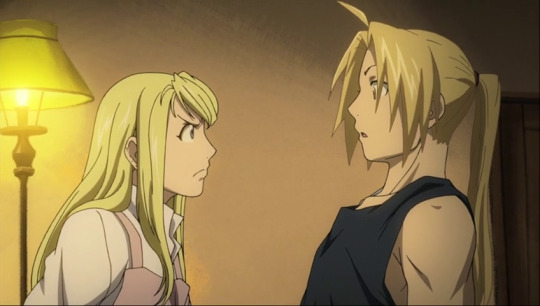
Winry Rockbell and Edward Elric in FMA:B. Slow burn, mutual pining, mutual cluelessness, what’s not to love? So soft and tender and funny all at the same time, and the mad respect Ed has for Winry is absolutely delightful. She does her own thing, and he’s totally supportive, just as she is of him. And a happily ever after??? UGH, I can’t, it’s perfect. The most straightforward and least convoluted of my whole list, and it’s comparatively easy to breeze through. FMA:B is great anyhow, so do yourself a favor and go watch it.
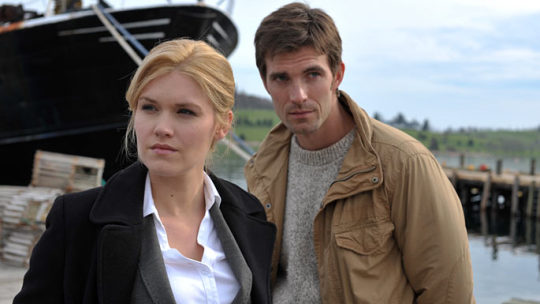
Audrey Parker/ Nathan Wuornos in Haven (with major caveats). Caveats first: they went overboard with the sexy stuff in my opinion. It got too smutty for me, but my tolerance for that stuff is super low, and it did still air on TV, so evidently it wasn’t as bad for the target audience as it was for my sex-in-media-repulsed self. I also find the final seasons to get a bit stale and repetitive in terms of them trying to advance the love story narrative (all the plot points for it got addressed in earlier episodes/seasons, so why are we going over it again??). They also have a bit of an issue in some episodes with dragging out conflicts because the characters just won’t talk to each other like adults. But overall, taken as a whole, it hits hard. Again, we have a slow burn, mutual pining dynamic that starts as a genuine platonic friendship, and transforms into a dimension and time defying chosen soulmates love story for the ages. The things they would do to save each other, even if it means they can never be together, just so they have the joy of knowing that their beloved is okay. The tiny ways they take care of each other- Audrey testing Nathan’s coffee to see if it’s too hot, Nathan slowing down so he doesn’t out-pace her, it’s just adorable.
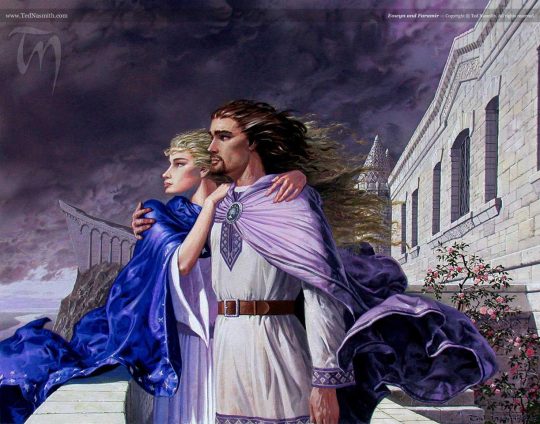
Faramir and Eowyn in The Lord of the Rings BOOKS. This is an interesting one because it happens really quickly and between two minor characters. But Tolkien did this really interesting thing where he established these two characters separately, and then brought them together and played off what we knew about each of them in context of everything else that had happened with the main story, and suddenly it has, as one of my professors would say, “the illusion of depth.” Faramir absolutely falls head over heels for Eowyn but won’t act until she can deal with her own crap and be emotionally available. Eowyn realizes that she was hung up on ideals, illusions, and false dichotomies. Faramir has been through a lot and is looking for peace. Eowyn is looking for who she really is when she realizes she has more than two choices in life. They find healing together, and in the process, find what they were looking for in each other. And all that happens in the space of, like, 4 pages. I LOVE IT.
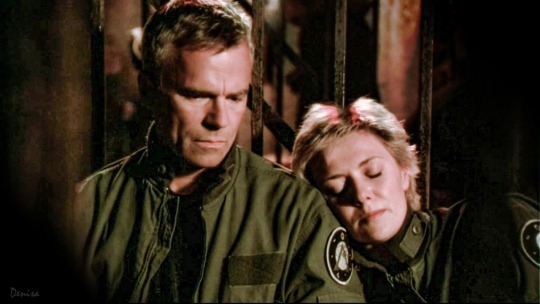
Sam Carter and Jack O’Neill in Stargate SG1. This one will hurt you to no end. You will hate life. But gosh dang if they aren’t perfect. This is the slowest burn and most mutual pining of all slow burn mutual pining ships to ever grace media. I’m talking 8 seasons of these two sharing feelings but being unable to express it for one reason or another. What are those reasons, you ask? Jack is her superior and respects her too much to put her in that position. No fraternization on the team. Sam has career aspirations, he won’t ruin her life. He’s got his own issues to work through and knows he isn’t emotionally available. Sam is clueless for a while, then when she realizes she has feelings for him but it couldn’t be because of their work dynamic and because he’s still dealing with his own crap, she tries to move on but keeps coming back to the unspoken fact that she still loves him. To the point that she breaks off her own engagement to a great guy because she realizes she was only trying to move on-- and wasn’t successful. They are clearly in deep for each other, and yet they keep making excuses why they can’t say it.
In the whole series, they never officially get together, and I HATE THAT. There are multiple alternate realities and timelines where they are together, and happy, but in the main timeline, they can’t get over themselves, and it hurts so bad because they’re so perfect. Jack knows she’s the smartest person in the room, and he supports her and defends her and listens to and defers to her. He respects her first as an expert, then as a colleague, and then as a woman whom he deeply loves even though he can’t find it in him to love himself. She appreciates his experience and leadership, and trusts him implicitly. She knows she’s got more book smarts, but relies on his judgement and ability to remain calm under pressure. She also knows she can be real with him, and he knows that when she calls him on his BS he better listen. She is his conscience, and he is her backbone. And in between episodes where they’re clearly pining for each other, and even during, they’re really great friends and a great team. I could seriously write an essay on why this ship is both perfect and intensely frustrating, but then again, you could just watch a great and classic series and see what I mean for yourself. (Then you’d also get to meet the perfection that is Teal’c, and watch Daniel Jackson’s transition from Milo Thatch in Space to sassy beefcake demigod who still loves archaeology.)
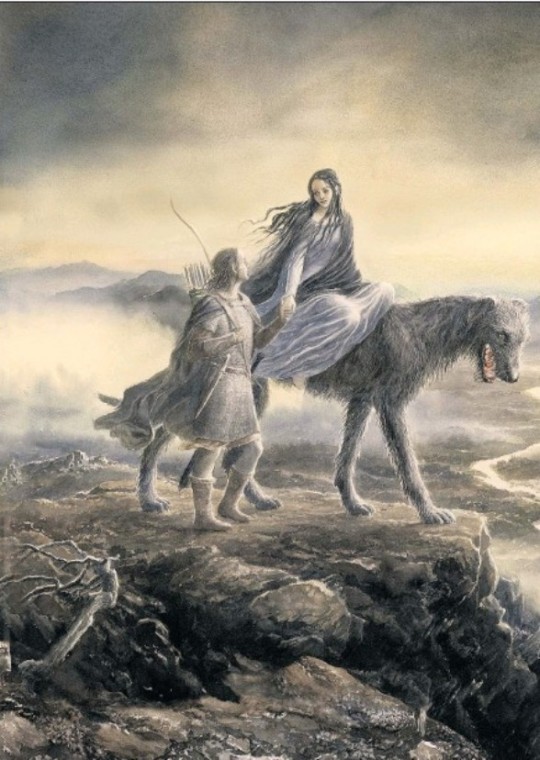
Beren and Luthien, Tolkien part 2, electric boogaloo. A love so powerful it transcends death, fate, hell and heaven all at once. It’s kind of wild and not what you’d expect if you’ve only read LotR (or only seen the movies), because it’s more a classic fairy tale than anything, but hot dang if it isn’t still one of the most powerful, moving, deeply impactful love stories in all of writing. It’s even a “love at first sight” narrative and I STILL fall hard for it. This story legit moves me to tears every dang time I read it, or even think about it too hard.
It starts as a simple “forbidden love” story, but these two loved each other so much that they defied one of the most powerful kings in all the world at that time (who was also Luthien’s dad, oopsies), defied Satan himself and marched into Hell just for the chance to be together, and then changed the very way the world works forever just so they could stay together and not be parted. Luthien is a total BEAST, while never giving up her gentle, loving, and tender nature. For the love of this man, she defies her father’s wishes and breaks herself out of her own dang tower to go rescue her prince instead of the other way round, she sends Sauron (yeah, he’s here too!) scurrying with his tail between his legs, wrecks his house, and frees all his slaves and prisoners just to try and get to Beren, drags his butt out of heck part 1, then willingly walks into literal, actual Hell with him and proceeds to enchant Satan and all the demons within. Then she gets her bf outta there after he loses his hand, and goes back to face her father unafraid. Basically, Beren undertakes a literally impossible task just for the chance to be with Luthien, but Luthien is the one that makes it happen because she loves him too much to sit around knowing he’s going to die. She’s willing to die with him rather than live without him, but more willing to dare death to come at her and get some because ain’t no way she’s losing him.
Then, at the last, when all should have been their happily ever after, everything goes wrong and she loses her beloved, and instead of mourning forever, she yeets off her mortal coil out of pure “Oh no you didn’t, not after all we went through” just to go stand before the God of Fate and the Dead and plead with him to change the rules of the universe itself just so that she can be with Beren. And he does it, because their love is so strong. Just for them, all of existence is rewritten so that they might never be parted.
And if you don’t think that’s the most beautiful thing you’ve ever heard, consider also: these two crazy kids were so wonderful that the Goodest Boy in all the world, a functionally immortal and super-intelligent dog sent from heaven itself by a literal god, willingly turned on all his masters and spontaneously learned intelligent speech just so he could help them out and be their Good Boy til the bitter end, thus (in Tolkien’s mythos) starting the whole “man’s best friend” thing with dogs. So yeah. And, uh, Tolkien based it on him and his wife, to the point of ripping their first meeting frame-for-frame from real life. It’s too much y’all.
Anyhow, this post is way, way too long, but I was just feeling the need to get that out there. Maybe I’ll have more in the future, but for now, this is what was on my mind. Particularly the last two.
46 notes
·
View notes
Text

real name: None. His mother never named him. Ornstein was a name given to him by the Prince of Sunlight, which he accepted and embraced as his own.
single or taken: Single and uninterested by default, but depends on the verse/timeline.
abilities or powers: All the innate characteristics of his species: superhuman strength, speed, endurance, enhanced senses, immunity to regular poisons and illness, partial immortality - unaffected by ageing. Plus his unique set of skills as a warrior and dragon slayer, including masterful use of the Light.
eye colour: Light amber, with notable specks of true luminous gold.
hair colour: Scarlet.
family members: Jeanne, Ornstein’s mother and only known relative. A former ranger hailing from a small settlement located at the northern side of the territory later known as Lordran.
pets: Spark. A leonine chimera gifted to him by Seath.
something they don’t like: Sloth, time-wasting, pointless boasting, sycophants, insulting jokes, humans.
hobbies/activities: gardening, sculpting, calligraphy, poetry, swimming, singing.
ever hurt anyone before: More people than he would ever care to count.
animal that represents them: Lion.
worst habits: Overworking himself to utter exhaustion, obsessive perfectionism, emotional distance and self-isolation, acting on prejudices, being judgemental, killing without mercy or remorse - when he deems it necessary, skipping meals, not eating his vegetables.
role models: Oddly enough none...? Maybe the Prince, back when he was younger. Ornstein was quick to realise they were very different, though, so it was just a matter of fighting style and techniques. Gwyn was someone he followed and obeyed, but he never tried to be like him - not to mention Ornstein lacked the worst of his narcissism. Besides, he’s fundamentally someone who defines himself by setting and achieving his own goals, having little interest or time to imitate what others do.
sexual orientation: demi-pansexual with a strong preference for masculine individuals.
thoughts on marriage/kids: Not for him. While most people want the supposedly ‘automatic’ happiness and conventionally respectable status a family should bring, Ornstein just doesn’t see himself partaking of that. His priorities are different, and his own concept of family doesn’t really fit seamlessly with societal expectations - for many reasons. Plus he’s certain he wouldn’t be a good father, and he loathes the idea of having children who’ll later suffer because of him. (In reality, he’d be a decent father... but that’s another story.)
style preferences: Anor Londo’s fashion was the ultimate expression of luxury and decadence. In a society so deeply infatuated with beauty as an indicator of goodness, looks transcended aesthetic to outright influence politics. From his armour to his everyday clothes, Ornstein did care for appearances and used them to reinforce his overall image. However, he would often favour attires that weren’t as elaborated and theatrical as those of most people from Gwyn’s Court. He relied on his own beauty and aimed to strategically enhance it, rather than burying himself under a plethora of jewellery, rich gowns and makeup. In a subtle way, it was yet another power-move from his part. A display of that which others had to fake or exaggerate instead.
approach to friendships: Most people might think his heart harbours sympathy for no one, but that’s not exactly true. He only has a small handful of friends, given an assortment of issues concerning trust and attachment. He also lacks interest in fleeting relationships, including platonic ones. However, the very few people he’d call friends are precious to him; deserving of the gifts of true kindness and honesty (oftentimes rare in Anor Londo) and also of his protection.
thoughts on pie: Sweets are a no-go. Meat pie is fine, though.
favourite drink: Fine wine, fresh water, warm milk with a tiny dash of honey.
favourite place to spend time at: His private garden.
swim in the lake or in the ocean: Lake, but the ocean is great too.
their type: He tends to favour individuals with a strong body, as an aesthetic and somewhat sexual preference. But as a demisexual/demiromantic who focuses on the deeper side of relationships, he doesn’t really have a specific type. Rather, he seeks certain interactions and characteristics that develop over time.
camping or indoors: Both.
TAGGED BY: @isalarevas <3!! TAGGING: @mageshot @maegtig @ofvergen��@abysstaken @proditeur @cultivatxr @inanisvitae @yellowfingcr @airxn @derjaegermond @sneakysouls @hearthwarm @abysswclker @anammxlech + YOU!!!!! Yes!!! do it and tag me !!! >:3
#AN OLD LEGEND // about#this was super interesting!#so actually tagging ppl here cause it might be fun for yall too#also yeah ornstein's bad habits include ruthless killing and not eating his veggies#lmao lemme have my silly fun
15 notes
·
View notes
Text
THE SHINHWA STORY: 20 YEARS YOUNG & STILL GOING STRONG
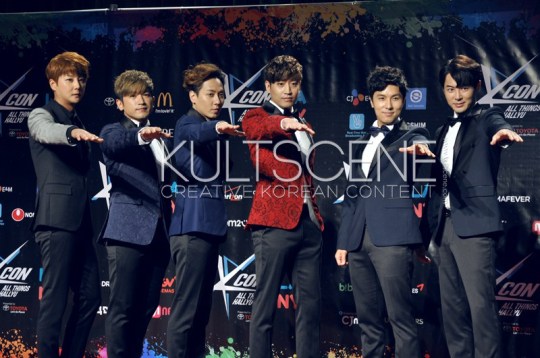
by Lavanya Singh
If you think about how long Shinhwa has been around, you don’t need to look past their 14th anniversary press conference, where member Jun Jin put things into perspective for everyone: “The members of Girls’ Generation were in elementary school when we were in SM Entertainment. Jessica and Hyoyeon wrote us letters back in the day.”
That was six years ago.
On March 24th, Shinhwa celebrated their 20th anniversary. Rightly, the band is listed in the Guinness Book of World Records as the longest-running boy group in the world that hasn’t disbanded or had a member leave in 19—well, 20 now—years. A closer look at the band and its popularity, however, pegs Shinhwa as artists who transcend numbers and charts, and who have found permanence in an otherwise transient industry.
THE START
The six members of Shinhwa debuted on March 24, 1998 under SM Entertainment, performing the single “Resolver” on KM Music Tank. To say that the band had a rocky start would have been an understatement—accusations of being a copy of label-mates H.O.T and the controversy following the Sokcho water accident that overshadowed the promotions of their song “Eusha Eusha” soon sparked rumours of disbandment. With the exception of some songs, the group’s debut album did not chart well, leading people to speculate that the band may have been a bad investment for SM.
With their second album “T.O.P,” however, came an edgier concept and mainstream success. “T.O.P.” won Shinhwa their first major music award for “Best Music Video”, and the trajectory only went upwards after that.
A LONG LINE OF FIRSTS
As both fans and writers, we know how much modern K-pop owes to the so-called first wave of Korean music. Not only was the era a fantastic prelude to the all-encompassing force of nature that K-pop would eventually become, but the artists who defined that wave also left behind a legacy that would inspire and drive the future generations. Seo Taiji and the Boys, for example, gave Korea quite possibly its first tryst with R&B, and member Yang Hyun Suk later established one of South Korea’s premier entertainment companies, YG Entertainment. S.E.S, one of K-pop’s early girl group successes and the first girl group from SM, would later go on to inspire numerous other girl groups.
For as long as they’ve been around, therefore, it’s only inevitable that Shinhwa’s legacy be an ode to their popularity. What’s surprising, though, is knowing just how much contemporary idol and fan culture owes to the band and their fandom, “Shinhwa Changjo”. (The name means “making a legend��, aptly complementing the band’s own name meaning ‘myth’ or ‘legend’.)
In 2002, while still under SM, the band released their sixth studio album, thus officially becoming the longest-running act in K-pop. A year later, while reviewing their contracts, SM offered to renew contracts with all members except vocalist Dong Wan. Rather than splitting up, Shinhwa decided not to renew their contracts with SM, and departed from the company as one unit, signing later with Good Entertainment. As somewhat of an unspoken trend in K-pop, artists who leave one company for another often experience a wane in popularity. Shinhwa, however, is one of the only bands in K-pop whose members went on to have incredibly successful careers despite a company change and the mandatory military enlistments. In fact, their first Daesang(or Grand Prize), for the seventh studio album Brand New, came in 2004, almost a year after leaving SM.
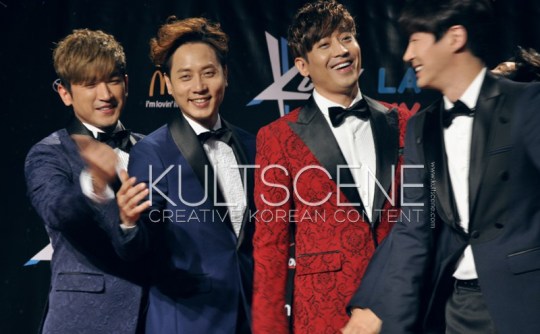
But just because they left the label that formed them didn’t mean Shinhwa broke away from SM entirely. In 2013, member Min Woo looked fondly upon his time at SM, saying: “[Founder] Lee Soo Man is truly an amazing person. From each member’s hairstyles to everything we did on stage, he took care of us meticulously. He used to talk to all of us about every little thing.”
Following their mandatory military enlistments, Shinhwa became the first K-pop group to establish their own entertainment company in 2011. For a while, the band was locked in a legal battle with SM Entertainment and Joon Media (formerly Open World Entertainment) for profits and use of the name ‘Shinhwa’. The case was, however, settled in 2015, and Shinhwa Company (which had been dubbed ShinCom for the duration of the case) came into existence.
Shinhwa was also one of the early trendsetters in the industry in terms of musical control. While their creative license was limited under SM, the members participated actively in the production of their albums after leaving. By that time, most members had released solo music and found their personal styles. The result was an eclectic combination of sounds on future albums, making the band a truly versatile act.
It’s not just their music and their exceptional team spirit that set Shinhwa apart, though: the band was the first in the industry to break away from the mainstream style of the time. When much of K-pop focused on trendy skinny jeans and bright colors (think SHINee’s “Replay” era), Shinhwa adopted a much more sophisticated style with clean-cut suits and cropped hair—quite uncommon for popular acts at the time.
Also uncommon was Shinhwa’s dedicated fandom, Shinhwa Changjo, who, honestly, were fandom goals before the term went mainstream. Shinhwa Changjo are credited with starting the popular rice wreath trend—it was member Hye Sung’s fandom who first sent rice wreaths to support his solo concert in 2007. Shinhwa’s fandom was also the first to have planted forests in support of their idols.
THE MAKING OF LEGENDS
Part of the reason why Shinhwa remains a groundbreaking act in K-pop is, as
The Atlantic
put it, their “smart self-awareness.” In an industry that’s sometimes too full to the brim with new acts, Shinhwa chose to evolve and mature in their own timeline, striking an attractive balance between age and trends. The result? Hilarious variety shows and appearances where the members didn’t, and continue to not, hesitate in poking fun at themselves, all topped off by the very refreshing devil-may-care attitude that came with spending years in the industry (I will never be able to hear the words “Do you smell something burning?” without laughing.)
youtube
In fact, despite their seniority in the industry, age hasn’t ever been something that’s held Shinhwa back: the band has embraced their late 30s with fervour and humour, even going so far as to admitting that having a “battle of stamina with younger groups” is pointless. Now that they don’t have the “weapon of youth”, they’ve turned their focus on charms that suit their age. There’s the cheeky SNL Korea broadcast where the members dress up as exhibits in a museum—only the exhibits are their younger selves from a decade ago—with visitors standing around, confused about who they’re supposed to be. There’s the sarcastic “Idol Retirement Insurance Plan” skit, where the members sold insurance plans to idols in the climax of their careers that included obsessive fans to stalk them and make them feel young. Or, if you need something else, there’s the infamous “Farting chorus” broadcast—which is exactly what it sounds like.
That’s probably the most endearing part about Shinhwa—with the passage of time, they made their own interpretations of what they were supposed to be, both as individuals and as a group, and molded the expectations to fit them than the other way round. As a unit, it makes them relatable. They never shy away from sharing both their successes and their struggles—the members have always been vocal about arguments among themselves, but have also been quick to admit how their long bonds have made working together easier. In a recent interview about their 13th studio album, member Jun Jin put the feeling into words: “If it weren’t for Shinhwa, Jun Jin wouldn’t exist.”
It isn’t just the marvelous teamwork; it’s also the fact that Shinhwa has never been a group that downplays their concerns, both as artists and businessmen. Group leader Eric expressed his anxiety about working in an industry where Shinhwa is one of the only groups left from the first generation: “We have no role models, nowhere to get advice. I think we have to grasp our future direction ourselves as we continue to work.”
They’ve also never had qualms about admitting to concerns about their company—Eric once talked about how Shinhwa realized that running a company was different than being an idol when they had to monitor how much money they spent on meals. Somewhere down the line, Shinhwa shed the skin of idols and became human, which brought them to closer to their fans.
Speaking of which, part of the reason why they remain popular favorites is also their relationships with their fans, which has always been more like that of bickering best friends and less like the typical fan-idol interactions. In fact, the group has never been hesitant to call out fans on their behavior. As a story about their first fan-sign goes, member Dong Wan told the fans that “Shinhwa is definitely not responsible for your lives.” He received some flak for that, but Dong Wan defended himself, saying that the “fans’ love could sometimes be over the top.” It was an example of how Shinhwa were mature since their early days, not caring about gratuitous fanservice and establishing a relationship of mutual trust with their fans.
youtube
K-pop is an ephemeral industry: every burst of fame and omnipresence is followed by a plateau where new groups come in and take over, and fandoms are inherited down the generations. Yet, Shinhwa is one of the only groups from the first generation of K-pop to not only continue making music, but to be loved by fans and the industry alike. They remain among the groups for which the word “groundbreaking” rings utterly true—because of their acceptance of the changing times; because of their self-deprecating and brilliant humor; and, most importantly, because of their steely resolve to always be one unit for themselves and their fans. They never take themselves very seriously, and that’s what makes them so endearing. If you’re just starting out with Shinhwa, check out the remake of their music video, “All Your Dreams,” which was released on the 20th anniversary of their debut.
youtube
What’s your favorite Shinhwa song? Let us know in the comment section below. Be sure to subscribe to the site and follow us on Facebook, Twitter, Instagram, and Tumblr to keep up with all of our posts.
Cr: KULTSCENE
L'HISTOIRE DE SHINHWA: 20 ANS, JEUNES ET TOUJOURS FORTS
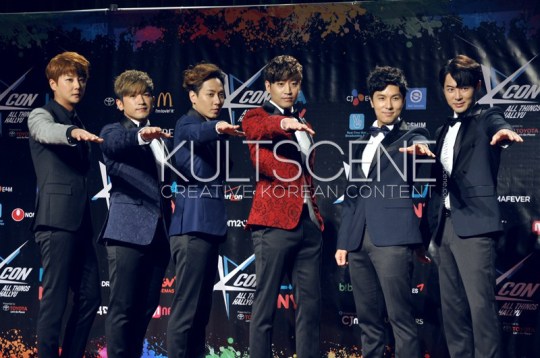
Si vous pensez à depuis combien de temps Shinhwa est présent, vous n'avez pas besoin de regarder après leur conférence de presse du 14e anniversaire, où le membre Jun Jin a mis les choses en perspective pour tout le monde: “Les membres de Girls' Generation étaient à l'école primaire quand nous étions à SM Entertainment. Jessica et Hyoyeon nous ont écrit des lettres dans le passé.”
C'était il y a six ans.
Le 24 mars, Shinhwa a célébré son 20ème anniversaire. À juste titre, le groupe figure dans le Livre Guinness des records comme étant le groupe de garçons le plus ancien au monde qui n'a pas été dissous ou dont un membre n'a quitté le groupe pendant 19 maintenant 20 ans. Cependant, un examen plus attentif du groupe et de sa popularité place Shinhwa en tant qu'artiste qui transcende les chiffres et les classements, et qui a trouvé sa permanence dans une industrie par ailleurs passagère.
LE DÉBUT
Les six membres de Shinhwa ont débuté le 24 mars 1998 sous SM Entertainment, interprétant le single "Resolver" dans l'émission KM Music Tank. Dire que le groupe a eu un début difficile aurait été un euphémisme - les accusations d'être une copie de ses coéquipiers H.O.T et la controverse suite à l'accident de Sokcho qui a éclipsé les promotions de leur chanson "Eusha Eusha" ont bientôt suscité des rumeurs de licenciements. À l'exception de certaines chansons, le premier album du groupe ne s'est pas bien placé, ce qui a amené les gens à spéculer sur le fait que le groupe aurait pu être un mauvais investissement par SM.
Avec leur deuxième album "T.O.P", cependant, est venu un concept plus incisif à la tendance et un grand succès. "T.O.P." a donné à Shinhwa leur premier prix majeur de musique pour "Meilleure Clip Video", et la trajectoire n'a augmenté qu'après cela.
UNE LONGUE LIGNE DE PREMIERS
En tant que fans et écrivains, nous savons ô combien la K-pop moderne doit à la soi-disant première vague de la musique coréenne. L'ère était non seulement un prélude fantastique à la force omniprésente de la nature de ce que la K-pop deviendrait finalement, mais les artistes qui ont défini cette vague ont également laissé un héritage qui inspirerait et guiderait les générations futures. Seo Taiji et les Boys, par exemple, ont probablement donné à la Corée son premier rendez-vous avec le R & B, et le membre Yang Hyun Suk a ensuite fondé l'une des premières compagnies de divertissement de Corée du Sud, YG Entertainment. S.E.S., l'un des premiers groupes de filles de K-pop et le premier groupe de filles de SM, inspira plus tard de nombreux autres groupes de filles.
Aussi longtemps qu'ils ont été présent dans la scène musicale, il est inévitable que l'héritage de Shinhwa soit une ode à leur popularité. Ce qui est surprenant, cependant, c'est de savoir à quel point l'idole contemporaine et la culture du fan doivent au groupe et à leur fandom, "Shinhwa Changjo". (Le nom signifie "faire une légende", complétant avec justesse le propre nom du groupe signifiant "mythe" ou "légende".)
En 2002, alors qu'il était encore sous la direction de SM, le groupe sortit son sixième album studio, devenant ainsi officiellement l'acteur le plus ancien de la K-pop. Un an plus tard, lors de l'examen de leurs contrats, SM a proposé de renouveler les contrats avec tous les membres, à l'exception du chanteur DongWan. Plutôt que se diviser, Shinhwa a décidé de ne pas renouveler leurs contrats avec SM, et a quitté la compagnie comme une unité, en signant plus tard avec Good Entertainment. Les artistes qui quittent une entreprise pour une autre connaissent souvent une baisse de popularité en tant que tendance tacite de la K-pop. Shinhwa, cependant, est l'un des seuls groupes de K-pop dont les membres ont connu des carrières incroyablement réussies en dépit d'un changement d'entreprise et des enrôlements militaires obligatoires. En fait, leur premier Daesang (ou grand prix), pour le septième album studio Brand New, est arrivé en 2004, presque un an après avoir quitté SM.
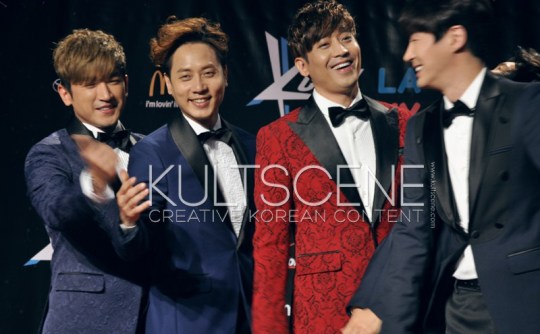
Mais ce n'est pas parce qu'ils ont quitté le label qui les a formés que Shinhwa s'est complètement détachée de SM. En 2013, le membre Min Woo regardait affectueusement son temps à SM, en disant: "[Fondateur] Lee Soo Man est vraiment une personne incroyable. Des coiffures de chaque membre à tout ce que nous avons fait sur scène, il a pris soin de nous méticuleusement. Il avait l'habitude de nous parler de tout et de rien. "
Suite à leurs engagements militaires obligatoires, Shinhwa est devenu le premier groupe K-pop à établir sa propre compagnie en 2011. Pendant un certain temps, le groupe a été engagé dans une bataille juridique avec SM Entertainment et Joon Media (anciennement Open World Entertainment) pour l'utilisation du nom 'Shinhwa'. L'affaire a toutefois été réglée en 2015, et Shinhwa Company (qui avait été surnommée ShinCom pour la durée de l'affaire) a revu le jour.
Shinhwa était aussi l'un des premiers faiseurs de tendances dans l'industrie en termes de contrôle musical. Alors que leur licence créative était limitée sous SM, les membres ont activement participé à la production de leurs albums après leur départ. À ce moment-là, la plupart des membres avaient sorti de la musique en solo et trouvé leur style personnel. Le résultat a été une combinaison éclectique de sons sur les futurs albums, faisant d'eux un groupe vraiment polyvalent.
Ce n'est pas seulement leur musique et leur esprit d'équipe exceptionnel qui distinguent Shinhwa: le groupe est le premier dans l'industrie à sortir du style traditionnel de l'époque. Quand une grande partie de K-pop se concentrait sur des jeans skinny à la mode et des couleurs vives (Shinee "replay" era), Shinhwa adoptait un style beaucoup plus sophistiqué avec des costards et des cheveux coupés courts.
Shinhwa Changjo, le fandom dévoué de Shinhwa, était également inhabituel et, honnêtement, qui était le fandom modèle avant même que le terme ne devienne courant. Shinhwa Changjo est connu pour avoir lancé la populaire tendance des couronnes de riz - c'était le fandom du membre Hye Sung qui avait envoyé des couronnes de riz pour soutenir son concert solo en 2007. Le fandom de Shinhwa était aussi le premier à avoir planté des forêts pour soutenir leurs idoles.
LA FABRICATION DE LÉGENDES
Une partie de la raison pour laquelle Shinhwa reste un acteur révolutionnaire de la K-pop est, comme l'atteste The Atlantic, leur «conscience de soi intelligente». Dans une industrie parfois trop pleine pour de nouveaux actes, Shinhwa a choisi d'évoluer et de mûrir dans leur propre ligne de temps, de trouver un équilibre attrayant entre l'âge et les tendances. Le résultat ? Spectacles de variétés hilarants et apparences où les membres n'ont pas hésité à se moquer d'eux-mêmes, tout cela étant surmonté par l'attitude très diabolique et rafraîchissante des années passées dans l'industrie (je ne serai jamais capable d'entendre les mots "Est-ce que tu sens quelque chose qui brûle ?" sans rire.)
youtube
En fait, en dépit de leur ancienneté dans l'industrie, Shinhwa n'a jamais connu de retenu avec l'âge: le groupe a embrassé la fin de la trentaine avec ferveur et humour, allant même jusqu'à admettre qu'avoir une “bataille d'endurance avec des jeunes groupes” est inutile. Maintenant qu'ils n'ont pas «l'arme de la jeunesse», ils se sont concentrés sur des charmes qui correspondent à leur âge. Il y a l'émission insolente de SNL Korea où les membres s'habillent comme des expositions dans un musée - seulement les expositions sont eux-mêmes plus jeunes d'il y a dix ans - avec des visiteurs qui se tiennent debout, confus au sujet de qui ils sont supposés être. Il y a le sketch sarcastique "Idol Retirement Insurance Plan", où les membres ont vendu des plans d'assurance à des idoles dans le climax de leur carrière qui incluaient des fans obsessionnels pour les traquer et les faire se sentir jeunes. Ou, si vous avez besoin d'autre chose, voici la tristement célèbre émission "Farting Chorus" - c'est exactement ce que ça donne.
C'est probablement la partie la plus attachante de Shinhwa - avec le passage du temps, ils ont fait leurs propres interprétations de ce qu'ils étaient censés être, en tant qu'individus et en tant que groupe, et ont modelé les attentes pour les adapter à eux même et non à l'inverse s'adapter aux attentes. En tant que groupe, cela fait que les gens arrivent à s'identifier Ils n'hésitent jamais à partager à la fois leurs réussites et leurs luttes - les membres ont toujours parlé ouvertement des arguments entre eux, mais ils ont aussi été prompts à admettre que leurs longs liens ont facilité le travail en équipe. Dans une récente interview au sujet de leur 13ème album studio, le membre Jun Jin a mis le sentiment en mots: "Si ce n'était pas pour Shinhwa, Jun Jin n'existerait pas."
Ce n'est pas seulement le merveilleux travail d'équipe; c'est aussi le fait que Shinhwa n'a jamais été un groupe qui minimise leurs préoccupations, à la fois en tant qu'artistes et hommes d'affaires. Le chef de groupe Eric a exprimé son inquiétude de travailler dans une industrie où Shinhwa est l'un des seuls groupes de la première génération: «Nous n'avons pas de modèles, nulle part pour obtenir des conseils. Je pense que nous devons nous saisir de notre orientation future alors que nous continuons à travailler. »
Ils n'ont jamais hésité à accepter les inquiétudes concernant leur entreprise - Eric a dit un jour comment Shinhwa s'était rendu compte que diriger une entreprise était différent d'être une idole quand ils devaient surveiller combien d'argent ils dépensaient pour les repas. Quelque part sur la ligne, Shinhwa a laissé la peau des idoles et est devenu humain, ce qui les a rapprochés de leurs fans.
En parlant de cela, une partie de la raison pour laquelle ils restent des favoris populaires est aussi leur relation avec leurs fans, qui a toujours été plus comme celle des meilleurs amis se chamaillant et moins comme les interactions typiques de fan-idole. En fait, le groupe n'a jamais hésité à appeler les fans sur leur comportement. Comme une histoire sur leur premier session d'autographe, Dong Wan a dit aux fans que "Shinhwa n'est certainement pas responsable de votre vie." Il a reçu des critiques pour cela, mais Dong Wan s'est défendu, disant que « l'amour des fans est parfois hors des limites du raisonnable ». C'était un exemple de la maturité de Shinhwa depuis ses débuts, ne se souciant pas de fanservice gratuit et d'établir une relation de confiance mutuelle avec leurs fans.
youtube
La K-pop est une industrie éphémère: chaque éclat de gloire et d'omniprésence est suivi d'un plateau où de nouveaux groupes entrent et prennent le relais, et les fandoms sont hérités à travers les générations. Pourtant, Shinhwa est l'un des seuls groupes de la première génération de K-pop à non seulement continuer à faire de la musique, mais à être aimé par les fans et l'industrie. Ils restent parmi les groupes pour lesquels le mot «révolutionnaire» sonne tout à fait vrai en raison de leur acceptation des temps changeants; à cause de leur humour désapprobateur et brillant; et, plus important encore, en raison de leur détermination à toujours être un groupe pour eux-mêmes et leurs fans. Ils ne se prennent jamais très au sérieux, et c'est ce qui les rend si attachants. Si vous débutez avec Shinhwa, regardez le remake de leur clip, "All Your Dreams", qui a été publié à l'occasion du 20ème anniversaire de leur premier album.
SHINHWA ALL YOUR DREAMS (2018) MV
32 notes
·
View notes
Text
the more Hellraiser 6 settles into my brain as a poorly executed depiction of some weird Hellraiser Dark Timeline (tm) implemented into actual canon, the more I realize that the folly if H6 is not necessarily how it’s depicting the established characters or mythos, but in how it’s going about perpetuating drama. H6 is destructive drama, it adds nothing to the story but deeper depths for it’s characters to sink into (this is also true for what I’ve heard of the Boom!Comics timeline, which is it’s own H2-divergent and offensively OOC Dark Timeline. but I digress).
The way I see it, Kirsty and Spencer are two tragic characters teetering on the edge of their own darkness, one soul not yet taken in by hell and the other trapped in it’s clutches. A lot of what made the whole Kirsty/Pinhead dynamic compelling to me existed within the suggestion of a strange push and pull between hell's clutches and transcendence from hell, and how both characters were caught up in those dilemmas and how they effected each-other’s stories. There was a perfectly good resolution to this in H2, when the monsterousness is stripped from Pinhead and he becomes Spencer, girl saves him, he saves girl, sacrifices himself and dies a noble death, etcetera etcetera. Parts of the scene were executed poorly but the concept was strong and surprising and unique for it’s genre. It fit the themes of the narrative by having both characters rise above darkness and escape, in one way or another. The problem is that this resolution, on top of being a little clunky, actually ended up coming far too soon in the story, because nobody involved expected that Pinhead was going to live on past his intended death to become the face of the franchise for seven more movies.
So how do you resurrect that drama and dig in deeper, after jumping the gun with the ending? H3 shoved Spencer’s soul back into Pinhead, which is a reasonable thing to do if you had to retcon his death. There was room to grow the storyline after that, even if the film was bad overall. H6 was the film to finally bring Kirsty back, and a small attempt was made to re-establish the character drama of the originals. That absolutely makes sense, because you could have essentially had a redux of the H2 ending, bringing everything around full-circle; tying up the loose ends created by the death retcon, and giving the fandom a true sense of the nostalgia they were looking for. But what we got was not really a re-establishement of the original drama.
Yes, it makes sense to have a now-obsessive Pinhead trying to drag Kirsty down with him, if you consider this behavior as a result of Spencer’s care and regard for Kirsty potentially evolving into a deeper attachment and then being distorted through Pinhead into obsession and destruction. It makes sense for the push and pull struggle between them and Hell to be re-established by this event, particularly because another man was putting Kirsty in peril, and for the threat of Hell to come closing back in on Kirsty because her psychological wounds were essentially being re-opened by her husband’s betrayal. Like, there was something here, folks. Something with potential.
But What we got from this reunion was the suggestion that Hell finally won them both, him already because of his second sacrifice in H3, and her because she was starting to give up her integrity and murdered three innocent people to escape. What we got instead was a barely there suggestion in a deleted scene that maybe Spencer’s soul twisted things around deep inside just enough to make Pinhead accept her deal and let her escape, if we read between the lines of the dialogue and also assume that the more human-like vocal distortion at the end of the scene was intentional, and not just, like, the spooky voice editing accidentally cutting out at the end of Doug Bradley’s line or something. I fully believe all that was there and intentional, but It’s still a pain in the ass that it’s mostly crumbs I’m picking off the plate, here.
So essentially, this was some vaguely juicy drama that exists for no purpose other than to pretend to be better and more meaningful than it really is, leaves the audience with the sense that something is sour and lesser than it could be, and drags the characters lower rather than gives their arcs any real resolution beyond the suggestion of even more suffering to come. Kind of like how I feel every time I attempt to eat strawberries.
4 notes
·
View notes
Text
HOW Design Live 2017: A Recap (Part 1)
by Maureen Adamo
HOW Design Live, the yearly gathering where designers can talk kerning, clients and the increasingly commonplace insanities of #creativelife and everyone totally gets it. As Stefan Mumaw likes to remind attendees in his networking event at the conference opening, “These are your people! This is your tribe.” And it’s true. The person next to you totally does understand where you’re coming from, whether you actually come from Miami, New York, Portland, LA, or the middle-of-nowhere-Kansas.
The themes of passion, productivity and voice took center stage from the get-go, creating a strong image of a world in which the designer-as-creator can thrive. If designers can relearn how to be themselves, if they can reach for more authenticity, it seems the experts and design leaders who spoke at HOW Design Live 2017 would be proud. In their words: Shake it up, get loud, be real, come back and play again tomorrow. As Sonja Rasula typified in her short presentation on embracing your inner weirdo, designers shouldn’t be afraid to bang the table sometimes, get passionately involved and be present: “NO! This font is better!”
This year, the conference programs were personalized — no cover alike for the more than 3,000 attendees, and each featured an inspirational quote from a past HOW speaker or thought leader. In the same spirit that the conference was framed by powerful words, I want to share the experience with a few insightful phrases I gleaned from this year’s speakers, starting with Tuesday’s and Wednesday’s sessions in the first of a two-post series.
Tuesday
Web Design Tools and Techniques for Print Designers
Jeremy Loyd and Ben Callahan, Sparkbox
“Every time you improve page load speeds, conversion goes up.”
Perhaps a dry start to the week, but wannabe slashies looking for a solid foundation in the crossover from print to web got a high-level overview of the techniques and processes Jeremy Loyd and Ben Callahan use in their work at digital agency Sparkbox. The masterclass session held an hour-and-a-half’s worth of info on everything from how to get projects started on the right note, with examples of kickoff exercises and research techniques (they use a lot of Google forms), to how they use a handful of tools and workflows to keep team members and clients on the same page, minimizing downtime incurred in rework and handoffs. Big ideas: Communicate the look of the project early and quickly, inform development with reusable templates and modules, and try pairing designer and developer in discrete work sessions to blast through snags and build a stronger team.
They offered collaborative notes on the conference at bit.ly/how2017. As of now, there are only a few sessions outlined, so any latecomers can add notes and help fill it out, or check back later to see what’s been updated.
Brian Collins
“Instead of minimum viable product, how about maximum f*#&@g love?”
This was such an amazing keynote on which to launch the conference and absolutely set the standard for all who followed. Brian Collins learned branding from his young exposure to the Catholic church, although it was essentially what could be deemed the bad old days of branding, perhaps. He experienced revival, in a close to literal sense, in seeing how religion was transformed into human connection, love and joy, when he encountered the uninhibited passion of the Chicago Mass Choir. Oh, and surprise! He brought them onstage — twice — and the whole world was filled with music and light. The lesson? We’re not designers of information, rules and regulations, systems or elitism. We’re designers of inspiration, of emotion, of hope.
You Gotta Make a Lot of Stuff Before You Can Make Stuff Like Yourself
Timothy Goodman
“I’d rather letter my own words horribly than someone else’s beautifully.”
For those who hadn’t been following the trajectory of the 40 Days of Dating co-conspirator and co-author (hello, anyone?), Timothy Goodman walked through how he became the guy who gets paid to Sharpie on walls. He said yes, took on editorial illustration to find his voice making tons and tons of work, cold-emailed a mentor or two when he got in over his head, and finally — the finishing move — politely ignored their advice when he saw the path to creating work that was uniquely his. Also, he’s over our collective obsession with hand-lettering other people’s quotes. Use your own words.
Wednesday
Out of Juice: How to Replenish Your Creativity Well
Terri Trespicio
“Commit to one thing instead of half-assing everything.”
The same time I was thinking it, my neighbor said it: “Yeah, that’s so me.”
Designers do have reputations for being a little distracted. There is so much shiny newness to elicit our attention and we’re ravenous consumers of culture, media, projects, hobbies and on and on and on. Which is great, because this informs our work. But it also can leave us a little empty when it comes to our own agendas, unable to leap at opportunity when it’s presented and broke when it comes to minting the currency of our craft, great ideas.
Pointing toward the work of the totally unpronounceable Mihaly Csikszentmihaly in his book on the subject, Trespicio thinks of creativity as a system, one that is used to transcend traditional ways of thinking, patterns or rules. It’s not a realm of mystery or exclusion, and as knowledge workers, everyone in business is entitled to think of themselves as artists.
In this light, she lays out some ground rules for how to keep the well overflowing, beginning with taking care of your vessel (that’s you, the physical body) with good sleep, diet and habits. I loved it when she said your mind is like a freshly fallen field of snow when you first wake up. If, like me, you’ve been searching for a metaphor to communicate the pristine quality you value in your late and early hours of the day, this one is perfect to try out on those who haven’t been getting the message about how disastrous you find morning headlines to be to your work. “Why would you let Matt Lauer trample on your snow?” Trespicio asks. Also, dream a little so you have some ideas in your back pocket in case anyone ever needs you to jump flat-footed into a project, like they do. Idle time is especially useful in cultivating those ideas, which Trespicio also finds incredibly important.
Slay Your Zombies, Slash Your Zigzags, Show Your Zing!
Sam Harrison
“Become unfamiliar with the familiar.” Sam Harrison, #HOWLive Invisible hulahooping with @zingzone pic.twitter.com/B4k9dRHrF6
— HOW Design (@HOWbrand) May 3, 2017
“Ideas happen at the speed of trust.”
If my back-to-back attendance of rut-busting creativity sessions means anything, it must be that it seems like it’s getting harder and harder to keep the juices flowing as everything else we’re asked to do takes greater precedence over doing our best work. You, too? Sam Harrison brought his wisdom to bear on my problem (and Terri was also in attendance at this session, so you really can’t get too much help in this area) with a prescription for keeping our minds loose and open: become unfamiliar with the familiar (take a peek at The Boring Conference to see what he means), avoid contempt for any idea before you start, don’t be afraid to play around with nonsense, leave technology behind every once in a while, stop self-limiting beliefs — and, for heaven’s sake, stop trying to be perfect. Perfectionism will hold you back; “Trying to make things perfect keeps you in place while others move forward.”
Malcom Gladwell, with DeeDee Gordon
“Do you want something bad now, or good a few weeks from now?”
Malcom Gladwell, who self-professedly has zero clients, proceeded to speak on behalf of designers and creative teams who deal with clients every day. While I think everyone in the room wanted to stand and slow clap when he said deadlines kill creativity, I immediately felt the cosmic vibration of every creative director in the world groaning in my head. And it was fantastic to hear him expound a tiny fable of the tortoise and the hare, in which the faster worker does get the job done speedily, but at a significant cost to quality, while the tortoise, who takes his time, submits a superior project in the end. The voice in my head this time was my own, though, and it said, “If only!” And I mean, if only we weren’t all feeling the pressure to be hares.
Gladwell says our world measures success by whether things are done on time, but asks what time has to do with creativity? To that end, he suggests we build diversity into our teams by working with people who are not only culturally diverse, but also diverse in performance traits. We shouldn’t be teams of only hares, or only tortoises.
I didn’t attend sessions in which this happened, but I got the sense from the #howlive Instagram posts (which were awesome) that his proposal attracted immediate commentary from other speakers who followed. And I think that was partly because it’s a very attractive idea that we can fight for more time, push back against clients and managers for the weeks or months we need to do better work — our best work, even. However, I could also feel the controversial thread of thought snap in the air a bit, because deadlines can often be the beauty queen in the creative pageant, and maybe we’re too comfortable with how often we say when the project is wrapped, “We did what we could with the time we had.” Maybe we’re letting all that pressure to be hares go too far?
Gladwell was hardly the only speaker to address how shortcuts and compressed timelines are affecting design, though. Pentagram’s Natasha Jen dropped the mic on the popularity of the concept of design thinking, describing it as a form of shorthand aimed at non-designers, which raises the question, “Why are non-designers being asked to design?” Jeffrey Zeldman, of A List Apart, looked at the sameness of the web, and pointed to web frameworks as a culprit, because they present fast and easy ways for non-programmers to learn how to make websites. He asked, “Which one of two possible websites are you designing?” Oh, and let’s not forget David Carson, who’d really like us to stop using flush-left, all-caps headlines for quick and easy, go-to typesetting. These people are asking us to spend more time on the work, not less.
So while it may not be an easy or popular notion, questioning our use of and practices around time and the deadline could be of value, lest we become design thinkers, rather than design doers.
Stay tuned for Part 2!
The post HOW Design Live 2017: A Recap (Part 1) appeared first on HOW Design.
HOW Design Live 2017: A Recap (Part 1) syndicated post
0 notes